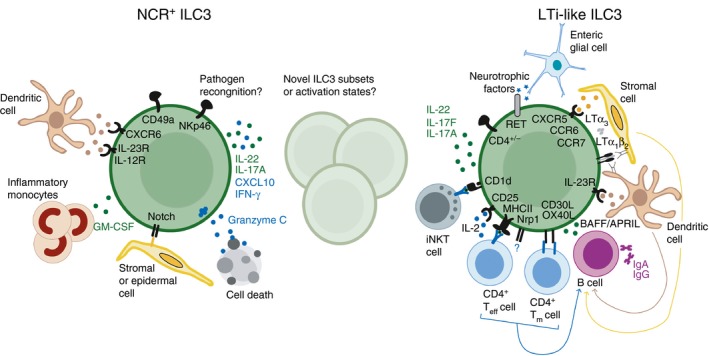Figure 2.

Group 3 innate lymphoid cell (ILC3) subset‐defining phenotypes and functions. Fully mature ILC3 subsets in peripheral tissues are broadly categorized into two major subsets; NKp46+ ILC3 (left panel) and lymphoid tissue‐inducer (LTi) ‐like ILC3 (right panel). Although both subsets express retinoid‐related orphan receptor γt (ROR γt) and share some core functions, emerging evidence suggests subset‐restricted functions. Phenotypic surface markers that typically used to define ILC3 subsets (bold) include natural killer (NK) ‐cell‐associated receptors, such as NKp46 and CD49a, for natural‐cytotoxicity‐receptor‐positive (NCR +) ILC3s, whereas LTi‐like ILC3s are primarily characterized by their expression of CCR6 and variable expression of CD4. Differential localization of NKp46+ ILC3 and LTi‐like ILC3 to the lamina propria and lymphoid tissues, respectively, is determined by differential chemokine receptor profiles. The difference in ILC3 subset localization is indicative of functional specialization. LTi‐like ILC3 express multiple molecules that endow this subset with the ability to indirectly and directly modulate innate‐like and adaptive immune responses in lymphoid tissues. In contrast, NCR + ILC3 appear to largely lack the ability to modulate adaptive immune responses but exhibit unique interactions with populations of myeloid and stromal cells in the tissue that drive the relatively pro‐inflammatory phenotype of this subset. Finally, although the majority of mature ILC3s exhibit NCR + or LTi‐like phenotypes recent transcriptomic studies indicate that multiple intermediate activation states may exist, which are likely determined by transition through metabolic states and differing environmental niches.
